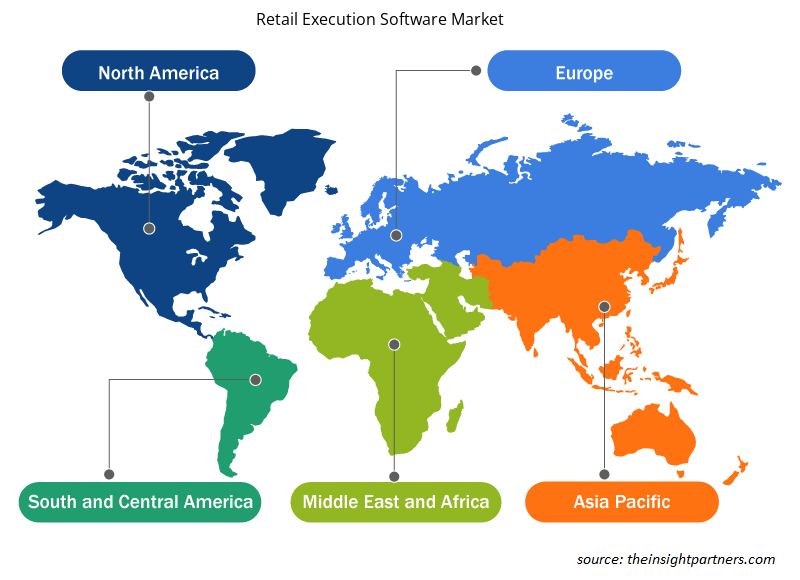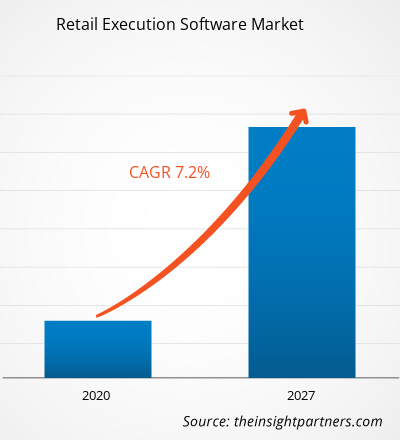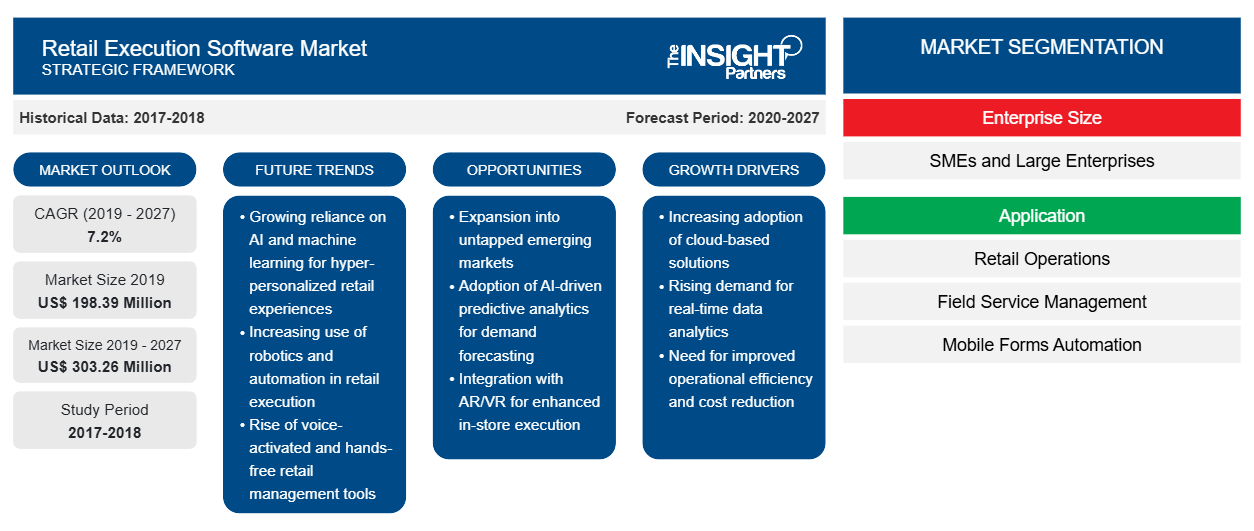Nel 2019, il mercato del software per l'esecuzione al dettaglio è stato valutato 198,39 milioni di dollari USA e si prevede che raggiungerà i 303,26 milioni di dollari USA entro il 2027; si prevede una crescita a un CAGR del 7,2% dal 2020 al 2027.
Il mercato globale del software di esecuzione al dettaglio sta assistendo a una crescita sostanziale dovuta alla crescente preferenza delle piattaforme di vendita al dettaglio e di e-commerce e alla crescente integrazione dei gateway di pagamento con il software di esecuzione al dettaglio. In base alla geografia, il Nord America ha guidato il mercato con una quota di fatturato del 31,13%, seguita da Europa e APAC. La presenza di un'economia in rapida crescita, la crescente adozione di tecnologie automatizzate, la crescente penetrazione di Internet e l'enorme adozione di software da parte degli utenti finali sono tra i principali fattori che dovrebbero guidare la crescita del mercato del software di esecuzione al dettaglio in queste regioni. Si prevede che il mercato del software di esecuzione al dettaglio in APAC crescerà al CAGR più elevato durante il periodo di previsione. La crescente adozione di tecnologie avanzate nel settore della vendita al dettaglio guida il tasso di adozione del software di esecuzione al dettaglio. Le aziende investono in software per semplificare le loro operazioni aziendali. In APAC, i mercati in più rapida crescita per la vendita al dettaglio e l'e-commerce sono India e Cina. I consumatori di questi paesi sono altamente inclini allo shopping online a causa della crescente penetrazione di Internet e le tendenze dello shopping online stanno trasformando diverse aree della vendita al dettaglio e dell'e-commerce nella regione. Pertanto, questi fattori stanno spingendo la crescita del mercato del software di esecuzione al dettaglio nell'APAC. Anche altre regioni in via di sviluppo, come MEA e SAM, sono destinate a crescere a un ritmo costante grazie alle crescenti iniziative governative per digitalizzare l'economia con l'adozione di tecnologie avanzate.
Personalizza questo report in base alle tue esigenze
Riceverai la personalizzazione gratuita di qualsiasi report, comprese parti di questo report, o analisi a livello nazionale, pacchetto dati Excel, oltre a usufruire di grandi offerte e sconti per start-up e università
-
Scopri le principali tendenze di mercato in questo rapporto.Questo campione GRATUITO includerà analisi di dati che spaziano dalle tendenze di mercato alle stime e alle previsioni.
Impatto della pandemia di COVID-19 sul mercato del software di esecuzione al dettaglio
Secondo l'ultimo rapporto dell'Organizzazione Mondiale della Sanità (OMS), Stati Uniti, Spagna, Italia, Francia, Germania, Regno Unito, Russia, Turchia, Brasile, Iran e Cina sono tra i paesi più colpiti dall'epidemia di COVID-19. La crisi sta influenzando negativamente le industrie in tutto il mondo. L'economia globale ha subito il colpo peggiore nel 2020 e probabilmente continuerà anche nel 2021. L'epidemia ha creato notevoli sconvolgimenti nei settori primari come logistica, vendita al dettaglio ed e-commerce. Il forte calo del settore della logistica internazionale sta frenando la crescita del mercato globale del software di esecuzione al dettaglio.
Approfondimenti sul mercato del software di esecuzione al dettaglio
Aumento dell'integrazione dei gateway di pagamento con il software di esecuzione al dettaglio
Alimenta la crescita del mercato del software di esecuzione al dettaglio
I pagamenti online sono relativamente popolari nell'area APAC, poiché la maggior parte dei consumatori utilizza i dispositivi mobili per pagare i beni. Diverse opzioni di pagamento elettronico popolari sono utilizzate per gli acquisti digitali mobili in paesi come Corea del Sud, Giappone, Singapore e Australia. Le aziende di gateway di pagamento in questi paesi offrono soluzioni di pagamento elettronico complete a vari fornitori di software di esecuzione al dettaglio per cavalcare l'onda dello sviluppo tecnologico. Inoltre, la crescita del mercato è attribuita ai progressi nella tecnologia dei gateway di pagamento e all'aumento dell'uso dei portafogli mobili. Si prevede che la crescente integrazione dei sistemi di gateway di pagamento con il software di esecuzione al dettaglio e l'aumento degli acquisti online, insieme ai progressi nei metodi di fatturazione, alimenteranno ulteriormente la domanda di software di esecuzione al dettaglio durante il periodo di previsione.
Approfondimenti di mercato basati sulle dimensioni aziendali
In base alle dimensioni aziendali, il mercato del software di esecuzione al dettaglio è diviso in grandi aziende e PMI. Nel 2019, il segmento delle grandi aziende ha rappresentato una quota significativa del mercato. Tuttavia, si prevede che il segmento delle PMI registrerà un CAGR significativo durante il periodo di previsione.
Approfondimenti di mercato basati sulle applicazioni
In base all'applicazione, il mercato del software di esecuzione al dettaglio è segmentato in operazioni al dettaglio, gestione del servizio sul campo, automazione dei moduli mobili, vendite sul campo, gestione delle promozioni commerciali, coinvolgimento dei dipendenti e altri. Nel 2019, il segmento delle operazioni al dettaglio ha rappresentato una quota significativa del mercato. Le operazioni al dettaglio riguardano la gestione di individui, catena di fornitura, layout del negozio, operazioni di cassa, inventario fisico e gestione di dati master, promozioni e prezzi. Il software di esecuzione al dettaglio per le operazioni al dettaglio fornisce ai negozi al dettaglio fisici strumenti per sfruttare le loro informazioni attuali e sfruttarle in un modo che avvantaggi la loro attività.
Le aziende sono fortemente impegnate nello sviluppo di nuovi prodotti per ottenere trazione nel mercato del software di esecuzione al dettaglio. Ad esempio, Salesforce ha lanciato un nuovo prodotto di settore, vale a dire Consumer Goods Cloud, che consente alle aziende di beni di consumo di alimentare la crescita dei ricavi e aumentare il ROI attraverso capacità di esecuzione al dettaglio migliorate. Di seguito sono elencati alcuni sviluppi da parte di attori chiave:
2020: StayinFront, Inc. retail data insight (RDI) ha esteso la sua partnership con Field Sales Solutions per analisi in tempo reale. La vista sul campo e la vista ROI di StayinFront RDI forniscono informazioni fruibili ai team di vendita sul campo. I servizi facilitano e massimizzano l'efficacia in negozio, consentendo ai clienti di Field Sales Solutions di fare di più, sapere di più e vendere di più.
2018: Intelligence Retail si è rivolta a IBM per migliorare la sua offerta principale e consentire ai suoi clienti di trarre vantaggio dal monitoraggio degli indicatori chiave di audit del negozio in tempo reale. Un nuovo modulo analitico della soluzione Intelligence Retail, basato sulle tecnologie IBM Watson Analytics integrate, è progettato per aiutare a monitorare efficacemente gli indicatori chiave dell'audit al dettaglio elaborando in tempo reale i big data, tra cui la disponibilità di beni sullo scaffale, la quota di scaffale, i prezzi e le promozioni
Approfondimenti regionali sul mercato del software di esecuzione al dettaglio
Le tendenze regionali e i fattori che influenzano il mercato del software di esecuzione al dettaglio durante il periodo di previsione sono stati ampiamente spiegati dagli analisti di Insight Partners. Questa sezione discute anche i segmenti e la geografia del mercato del software di esecuzione al dettaglio in Nord America, Europa, Asia Pacifico, Medio Oriente e Africa e America meridionale e centrale.

- Ottieni i dati specifici regionali per il mercato del software di esecuzione al dettaglio
Ambito del rapporto di mercato sul software di esecuzione al dettaglio
| Attributo del report | Dettagli |
|---|---|
| Dimensioni del mercato nel 2019 | 198,39 milioni di dollari USA |
| Dimensioni del mercato entro il 2027 | 303,26 milioni di dollari USA |
| CAGR globale (2019 - 2027) | 7,2% |
| Dati storici | 2017-2018 |
| Periodo di previsione | 2020-2027 |
| Segmenti coperti |
Per dimensione aziendale
|
| Regioni e Paesi coperti |
America del Nord
|
| Leader di mercato e profili aziendali chiave |
|
Densità dei player del mercato del software di esecuzione al dettaglio: comprendere il suo impatto sulle dinamiche aziendali
Il mercato del software di esecuzione al dettaglio sta crescendo rapidamente, spinto dalla crescente domanda degli utenti finali dovuta a fattori quali l'evoluzione delle preferenze dei consumatori, i progressi tecnologici e una maggiore consapevolezza dei vantaggi del prodotto. Con l'aumento della domanda, le aziende stanno ampliando le loro offerte, innovando per soddisfare le esigenze dei consumatori e capitalizzando sulle tendenze emergenti, il che alimenta ulteriormente la crescita del mercato.
La densità degli operatori di mercato si riferisce alla distribuzione di aziende o società che operano in un particolare mercato o settore. Indica quanti concorrenti (operatori di mercato) sono presenti in un dato spazio di mercato in relazione alle sue dimensioni o al valore di mercato totale.
Le principali aziende che operano nel mercato del software di esecuzione al dettaglio sono:
- Bizom (Mobisy Technologies Private Limited)
- EdgeCG (StayinFront, Inc.),
- Intelligenza al dettaglio
- Mobisoft
- Sonda POP
Disclaimer : le aziende elencate sopra non sono classificate secondo un ordine particolare.

- Ottieni una panoramica dei principali attori del mercato del software di esecuzione al dettaglio
Per dimensione aziendale
- Grandi Imprese
- PMI
Per applicazione
- Operazioni di vendita al dettaglio
- Gestione del servizio sul campo
- Automazione dei moduli mobili
- Vendite sul campo
- Gestione della promozione commerciale
- Coinvolgimento dei dipendenti
- Altri
Per Geografia
-
America del Nord
- NOI
- Canada
- Messico
-
Europa
- Francia
- Germania
- Italia
- Regno Unito
- Russia
- Resto d'Europa
-
Asia Pacifico (APAC)
- Cina
- India
- Corea del Sud
- Giappone
- Australia
- Resto dell'APAC
-
Medio Oriente e Africa (MEA)
- Sudafrica
- Arabia Saudita
- Emirati Arabi Uniti
- Resto del MEA
-
America del Sud (SAM)
- Brasile
- Argentina
- Resto del SAM
Profili aziendali
- Bizom (Mobisy Technologies Private Limited)
- Servizi di hosting di terze parti (Store.com)
- Intelligenza al dettaglio
- Mobisoft
- Sonda POP
- Spring Mobile Solutions, Inc.
- Società a responsabilità limitata
- Valomnia
- VINCERE
- Gruppo Kantar
- Analisi storica (2 anni), anno base, previsione (7 anni) con CAGR
- Analisi PEST e SWOT
- Valore/volume delle dimensioni del mercato - Globale, Regionale, Nazionale
- Industria e panorama competitivo
- Set di dati Excel
Report recenti
Rapporti correlati
Testimonianze
Motivo dell'acquisto
- Processo decisionale informato
- Comprensione delle dinamiche di mercato
- Analisi competitiva
- Analisi dei clienti
- Previsioni di mercato
- Mitigazione del rischio
- Pianificazione strategica
- Giustificazione degli investimenti
- Identificazione dei mercati emergenti
- Miglioramento delle strategie di marketing
- Aumento dell'efficienza operativa
- Allineamento alle tendenze normative























 Ottieni un campione gratuito per - Mercato del software di esecuzione al dettaglio
Ottieni un campione gratuito per - Mercato del software di esecuzione al dettaglio